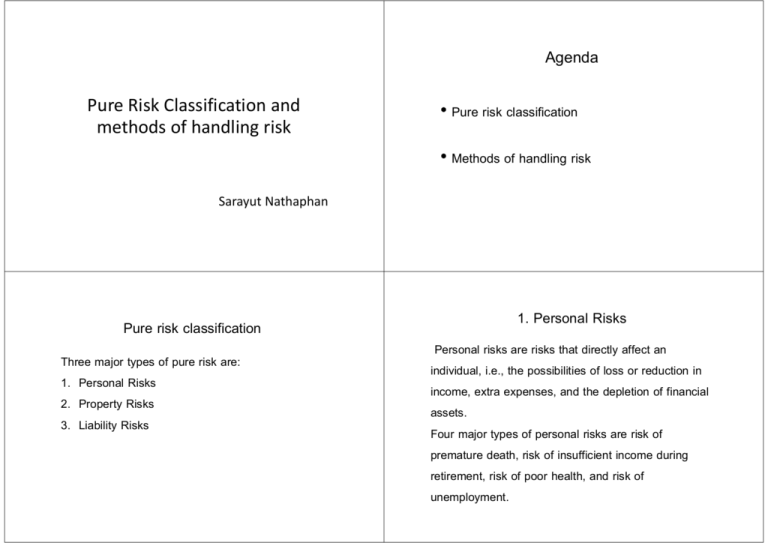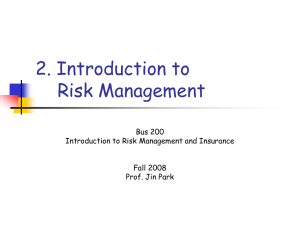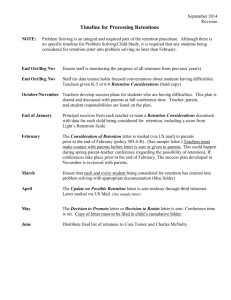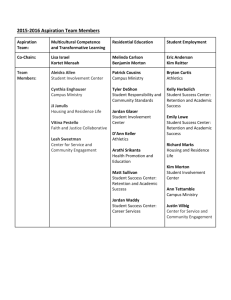Agenda
advertisement

Agenda Pure Risk Classification and methods of handling risk • Pure risk classification • Methods of handling risk Sarayut Nathaphan Pure risk classification Three major types of pure risk are: 1. Personal Risks 2. Property Risks 3. Liability Risks 1. Personal Risks Personal risks are risks that directly affect an individual, i.e., the possibilities of loss or reduction in income, extra expenses, and the depletion of financial assets. Four major types of personal risks are risk of premature death, risk of insufficient income during retirement, risk of poor health, and risk of unemployment. 1. Personal Risks 1. Personal Risks 1.1. Risk of premature death is defined as the death of a family head with unfulfilled financial obligations, i.e., dependents to support, a mortgage to be paid off, or children to educate. Q: the death of a child age seven is a premature death or not? Q: how to define human life value? 1.2. Risk of insufficient income during retirement 1.3. Risk of poor health: the risk of poor health includes both the payment of catastrophic medical bills and the loss of earned income. 1.4. Risk of unemployment 2. Property Risks 2. Property Risks Risk of having property damaged or lost from numerous causes, i.e., fire, lightning, tornadoes, windstorms, theft of property, etc. Two major types of property loss are direct and indirect loss. Direct loss is defined as a financial loss that results from the physical damage, destruction, or theft of the property. Indirect loss is a financial loss that results indirectly from the occurrence of a direct physical damage or theft loss. In the other words, indirect loss can be viewed as “consequential loss”. This may include the extra expenses incurred as we have to set up an alternative operating site to prevent losing customer to competitors. Ex: you own a business and your factory was damaged by fire, point out direct a indirect losses. 3. Liability Risks One held legally liable if one does something that results in bodily injury or property damage to someone else. • No maximum upper limit w.r.t. to the amount of loss. • A lien can be placed on your income and financial assets to satisfy a legal judgments. • Legal defense cost can be enormous. Methods of Handling Risk There are five major methods of risk handling. 1. Avoidance 2. Loss control 3. Retention 4. Noninsurance transfers 5. Insurance Loss control Loss control Loss control consists of certain activities that reduce both the frequency and severity of losses. Two major objectives in loss control 1. Loss Prevention aims at reducing the probability of loss so that the frequency of losses is reduced. The goal of loss prevention is to prevent the loss from occurring. 2. Loss Reduction aims at reducing severity of a loss after it occurs. Ex. Sprinkler systems at SET help reducing severity of loss due to fire during political unrest in May 2010. Retention Retention means that an individual or a business firm retains all or part of a given risk. Risk retention can be active or passive. 1. Active risk retention means that an individual is consciously aware of the risk and deliberately plans to retain all or part of it. Retention Risk retention is appropriate primarily for highfrequency, low-severity risks where potential losses are relatively small. Retention Ex. Motorist may wish to retain the risk of small collision by purchasing an auto insurance policy with $500 or higher deductible. 2. Passive risk retention: certain risks may be unknowingly retained because of ignorance, indifference, or laziness. Ex. Workers with earned incomes are not insured against the risk of total and permanent disability. Noninsurance transfer Risk is transferred to a party other than an insurance company. Methods of risk transfer are: 1. Transfer of risk by contracts 2. Hedging price risks 3. Incorporation of a business firm Noninsurance transfer 1. Transfer of risk by contracts Ex. The risk of defective TV or stereo set can be transferred to the retailer by purchasing a service contract, which makes the retailer responsible for all repairs after the warranty expires. Insurance Pure risk is transferred to the insurer via insurance. Noninsurance transfer 2. Hedging price risks: hedging is a technique for transferring the risk of unfavorable price fluctuations to a speculator by purchasing and selling future contracts on an organized exchange. Ex. Fixed Income fund managers with long-term Tbonds may hedge against rising of interest rate by short future contracts.





